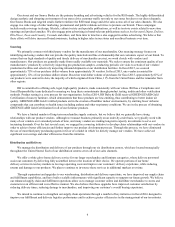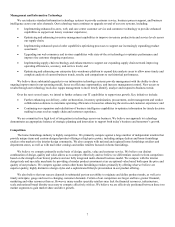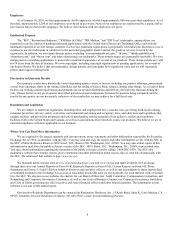Restoration Hardware 2015 Annual Report Download - page 19
Download and view the complete annual report
Please find page 19 of the 2015 Restoration Hardware annual report below. You can navigate through the pages in the report by either clicking on the pages listed below, or by using the keyword search tool below to find specific information within the annual report.16
If we decide to close an existing or future store, we may nonetheless have continuing obligations with respect to that property
pursuant to the applicable lease or ownership arrangements, including, among other things, paying the base rent for the balance of the
lease term. Our ability to re-negotiate favorable terms on an expiring lease, to arrange for the sale of an owned property or to negotiate
favorable terms for a suitable alternate location could depend on conditions in the real estate market, competition for desirable
properties, our relationships with current and prospective landlords and other factors that are not within our control. Our inability to
enter into new leases or renew existing leases on terms acceptable to us or be released from our obligations under leases or other
obligations for stores that we close could materially adversely affect our business and results of operations.
A number of factors that affect our ability to successfully open new stores within the time frames we initially target or optimize our
store footprint are beyond our control, and these factors may harm our ability to execute our strategy of sizing stores to the
potential of the market, which may negatively affect our results of operations.
We are focused on sizing our assortments and our stores to the potential of the market by adjusting the square footage and
number of stores on a geographic market-by-market basis. We plan to optimize our real estate by continuing to open larger square
footage Galleries in key markets and relocating or closing selected stores in these or adjacent markets. When we address the
introduction of new stores in a particular market or changes to, or closure of, existing stores, we must make a series of decisions
regarding the size and location of new stores (or the existing stores slated to undergo changes or closure) and the impact on our other
existing stores in the area or being without presence or “out of the market”.
Our ability to maximize the productivity of our retail store base, depends on many factors, including, among others, our ability to:
• identify suitable locations, the availability of which is largely outside of our control;
• size the store locations to the market opportunity;
• retain customers in a certain geographic market when we close stores in such market or an adjacent market;
• negotiate acceptable new lease terms or lease renewals, modifications or terminations;
• efficiently build and equip new stores or remodel existing locations;
• source sufficient levels of inventory to meet the needs of changes in our store footprint in a timely manner;
• successfully integrate changes in our store base into our existing operations and information technology systems;
• obtain or maintain adequate capital resources on acceptable terms;
• avoid construction or local permit delays, construction accidents and injuries and cost overruns in connection with the
opening of new stores or the expansion or remodeling of existing stores;
• maintain adequate distribution facilities, information systems and other operational systems to serve our new stores and
remodeled stores; and
• address competitive, merchandising, marketing, distribution and other challenges encountered in connection with
expansion into new geographic areas and markets.
We have experienced delays in opening some new stores within the time frames we initially targeted, and may experience such
delays again in the future. Any of the above challenges or other similar challenges could delay or prevent us from completing store
openings or the additional remodeling of existing stores or hinder the operations of stores we open or remodel. If any of these
challenges delays the opening of a store, our results of operations will be negatively affected as we will incur leasing and other costs
during the delay without associated store revenue at such location. New or remodeled stores may also not be profitable or achieve our
target return on investment. Unfavorable economic and business conditions and other events could also interfere with our plans to
expand or modify store footprints. Our failure to effectively address challenges such as those listed above could adversely affect our
ability to successfully open new stores or change our store footprint in a timely and cost-effective manner and could have a material
adverse effect on our business, results of operations and financial condition.
























